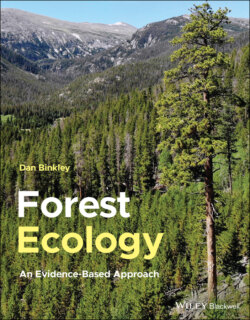Читать книгу Forest Ecology - Dan Binkley - Страница 35
All Objects Shine; Hot Objects Shine Brightly
ОглавлениеRadiation from the sun can be felt by holding out a hand in bright sun; the hand absorbs the solar radiation and warms up. We can see the hand illuminated by sunlight, because some of the light reflects from the hand and reaches our eyes. Another radiation story is also occurring, invisible to our eyes. The hand is also “shining” like the sun, emitting radiation to the environment around it. The cooler temperature of the hand means the wavelengths of radiation emitted are much longer than sunlight (a long wavelength is the same as a low frequency). The emission of radiation by the hand removes energy, and would lead to cooling of the hand unless another source of energy kept the hand warm.
The radiant energy emitted by the sun is called “shortwave” radiation, because of the short wavelengths (between about 400 and 700 nm for the visible portion of the solar spectrum). Objects at temperatures commonly encountered in forests “shine” or emit radiation at longer wavelengths, on the order of 10 μm. Longwave radiation may be sensed by skin as warmth, even though the weak radiation cannot be detected by our eyes.
The differences in the wavelength of light that shines (or is “emitted”) from an object are associated with very large differences in the amount of energy transfer. A very hot object emits shorter wavelengths of light, along with much higher amounts of energy (Figure 2.6). An object at room temperature (about 20 °C) shines out about 420 W of energy for each m2 of surface area. If the same object warmed to 37 °C (typical human body temperature), the energy transfer would rise to 520 W m−2. The loss of this emitted energy cools the objects, which in turn lowers the rate of further losses of energy. The energy loss may be counteracted by any energy being added to the surface from the environment (in the form of radiation, or hot air), and temperatures stabilize when energy gains from the environment match the energy losses.
FIGURE 2.6 All objects emit radiation to the environment, and hotter objects emit more energy (for a given surface area) than cooler objects. If the temperature of a soil surface increased from 20 to 40 °C, the emission of energy from the soil into the air would increase from 420 to 550 W m−2 (based on Stefan‐Boltzmann Law, and assuming that the objects are very good emitters (“black body” emission rates).
